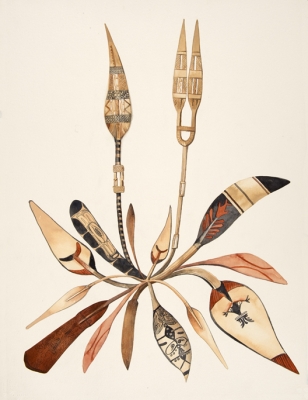To search the RPR site click here
The Curious Nature of Objects: Paintings by Sue Johnson 28 January to 19 June 2011
The Exhibition
In a project designed especially for the University of Oxford’s Pitt Rivers Museum, artist Sue Johnson takes on the role of a quasi-naturalist as she imagines new species of flora and fauna. To create her works, Johnson has been researching the illustrated catalogue of the more than 20,000 objects in the ‘second’ collection of General Augustus Henry Lane Fox Pitt-Rivers (1827–1900); that is, the collection he made after he had given his ‘first’ collection to the University of Oxford in 1884. This ‘second’ collection is now scattered around the world in hundreds of public and private collections.
In this new work, Johnson blurs the boundaries between the natural and cultural worlds. At first glance, her watercolours appear to be authentic natural history illustrations documenting newly discovered plants and animals. On closer inspection, however, it becomes clear that each vision depicts a hybrid organism with origins in the world of objects made by human hands in diverse cultures. For this project, Johnson has created a transformative space in which inanimate objects—pots, lamps, masks, weapons, shields, smoking paraphernalia, ceremonial objects, musical instruments, canoe paddles, and more—become animate. In Johnson’s hands, objects that have been made in nature’s image—by mimicking shapes and patterns—morph into plants and animals.
Johnson’s fantastic landscape is populated by such new hybrid species as the Domestic Gourd Plant and Paddling Bush. In Birds Without Feathers, it is a place where decorative and functional objects made in the shape of birds now ‘perch’ precariously on branches of a most unusual tree. Plants are often named after things they resemble in the world, and in the artist’s hands such familiar species as the Prickly Shield Fern are now transformed into the thing that inspired its name.
As the pace and scope of genetic engineering increases in the twenty-first century, with results and consequences that cannot fully be controlled or imagined, Johnson’s work explores the gap between the artificial and natural, as she creates a magical space to contemplate the secret lives of objects and the complex cross-pollination between the natural and cultural worlds.
About the Artist
Sue Johnson has worked collaboratively with museums and rare book libraries for many years, creating exhibitions based on works from collections at The Museum of the American Philosophical Society and the Rosenbach Museum and Library, both in Philadelphia, Pennsylvania. Since 1995, her work has comprised an episodic project under a loose conceptual umbrella entitled The Alternate Encyclopedia, with a series of exhibitions in museums, galleries, and alternative spaces throughout the United States of America. For this work she has created fictitious publications and artefacts based on authentic materials, the overall amalgam comprising a Wunderkammer to be constructed and held in the mind, a new kind of cabinet of curiosities. Individual series of her works explore genetic engineering and environmental crises, consumer culture in history, the role of women in science, as well as Alice’s Adventures in Wonderland and other literary works. Throughout this work, the role of the artist in picturing new knowledge has been underscored. Johnson is currently living and working in Oxford, where she is a Visiting Scholar in Residence at the Centre for Medieval & Renaissance Studies, Oxford. She is also Professor of Art in the Department of Art & Art History at St Mary’s College of Maryland. For more information, visit her website.
Rethinking Pitt-Rivers
This exhibition by Sue Johnson has been developed in association with the major three-year research project ‘Rethinking Pitt-Rivers: Analysing the Activities of a Nineteenth-Century Collector’ (2009–2012) of which Johnson is an associate researcher. Funded by a grant from The Leverhulme Trust, the project will provide a comprehensive account of the collecting activities of General Pitt-Rivers (1827–1900) in the context of the second half of the nineteenth-century. The project team, led by Jeremy Coote and Alison Petch at the Pitt Rivers Museum, are looking in detail at how he acquired his collections, but also at what he did with them, including the gifts he gave, the exhibitions and displays he organized, the talks and lectures he presented, and the papers he published. A primary focus in the early stages of the project has been the nine-volume manuscript catalogue of Pitt-Rivers’s ‘second’ collection held in the Department of Manuscripts and University Archives at Cambridge University Library (MS Add.9455), the images in which have inspired the work presented by Sue Johnson in this exhibition.
Sue Johnson and the Pitt Rivers Museum are pleased to acknowledge the support and cooperation of Mr Anthony Pitt-Rivers, The Centre for Medieval & Renaissance Studies, Oxford and St Mary's College of Maryland, The Leverhulme Trust, and the Department of Manuscripts and University Archives at Archives at Cambridge University Library.
Thanks to Jon Eccles, Pitt Rivers Museum, who installed the exhibition.
Details of the works on display
Which pages of the second Pitt-Rivers catalogue inspired Sue?





